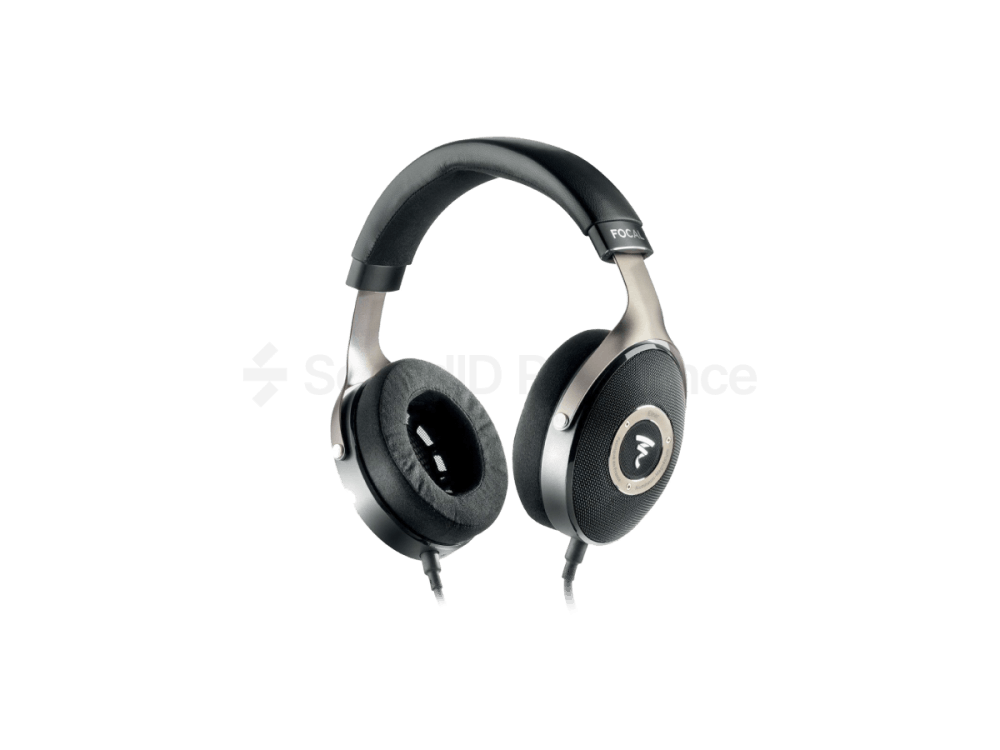One of the trademarks of Focal in hi-fi speakers and studio monitors has been the use of various exotic material tweeters, most notably – beryllium. In mid-2016 the French company released two open-back headphones which would bring their exotic material science to personal audio. The Utopia, a 4000$ hyper-headphone that uses the bespoken pure beryllium diaphragm driver, while the more pedestrian Elear – an aluminum-magnesium alloy one. It’s worth noting that the vast majority of headphone drivers use a plastic polymer single-piece diaphragm and surround assembly. Here Focal brings multiple innovations to the table, the aforementioned convex metal disk is glued to a separate surround as is commonly found in loudspeaker drivers.
As you can see the Elear’s driver looks more akin to a regular metal loudspeaker driver. In theory, the metal diaphragm should be more rigid than a plastic one and thus move without wobbling, read on to see whether that’s true in practice!
- Very good tonal response
- Superbly low THD
- Very Comfy
- Looks SHARP!
Pros list with SoundID Reference calibration
- Extra low end extension
- Highs get cleaned up
- Hardly affordable
- Highs are slightly coloured
The Focal Elear can be driven to a respectable SPL from most headphone jacks, so a dedicated headphone amp isn’t required. At the same time, the headphone likely will scale in sound quality with a better amplifier and DAC pairing. The 80 Ohm impedance means that the Elear will do fine on headphone outputs with no more than 10 Ohm output impedance, higher will accentuate the 80 Hz region.
Focal has knocked it out of the park here! Elear looks and feels like a proper 1000$ headphone. The presentation box is impeccable and so is the build quality of the headphone. The only nit to pick would be the cable, it’s very long and thick. If one is sitting at a desk the 3m cable would prove unwieldy and the thickness would make it hard to roll up neatly. The construction is mostly metal and both ear pads and cable are easily replaceable.
The measurements show a respectable lack of severe peaking, which is a prerequisite for a good-sounding headphone. The overall tuning is rather mid-centric, but not annoyingly so. Engineers should take note that this might lead to a tad thin-sounding mids in the resulting mix. Around 3-4kHz there’s a familiar looking dip which again, doesn’t sound offensive, but dulls the edge of many string and synthetic sounds, especially when distortion is applied. The slight peaking in the highs does color them, but not enough to make overtones too accentuated. Bass response is very good for an open back headphone.
Again, very good job here. The worst case is a 1.5 dB difference, which only occurs in very narrow frequency bands and shouldn’t affect imaging.
First let’s get out of the way the obvious, at 450 grams the Elear isn’t light! Luckily Focal engineers know a thing or two about ergonomics and there are no pressure points to cause discomfort over time. Both the ear pads and the headband are microfiber and don’t get hot even after prolonged use.
As is the case with all high-end headphones, this is a hard question. Over a fan-favorite Sennheiser HD 650, the Elear has only got a firm advantage in THD, the tonality is more colored. Then there’s of course the whole unboxing experience thing and owning an actual upper-tier headphone.
There simply isn’t any to speak of. What little there remains is mainly 2nd harmonic and thus inoffensive or rather in this case – utterly inaudible.
The inner diameter of Elear’s ear pads is rather large and allows for multiple wearing positions regardless of pinna size. While this provides superb comfort, consistency between listeners suffers. Most of the changes occur above 5 kHz.
How much do they differ pair to pair in terms of frequency response?Sample-to-sample consistency is also great. Looks like Focal are good at both innovation and manufacturing.
Rating
Conclusion
As a headphone enthusiast, I’m happy that Focal’s gamble with innovation has paid off, it’s not often when I get excited by a full-sized open-back headphone. Should studio people get excited? I think so, it’s not often you’re sacrificing so little when moving up from Sennheiser HD 650 to get into the upper echelons of headphone listening.
Final Rating
Calibration Enabled
Calibration







